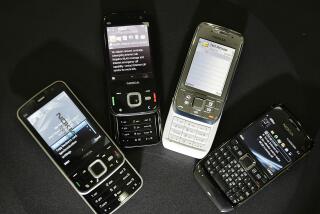THE GOODS : Dialer’s Choice : With Everything From a Basic Black Rotary to a 25-Channel Cordless, Consumers Have Almost as Many Telephone Options as There Are Area Codes
The white-haired man in a cowboy hat and jeans is complaining about his transportable mobile phone. The battery’s low, he says, lugging the phone by its strap as he stalks to the service counter of the AT&T; Phone Center in Pasadena. He bought it maybe six months ago. All he knows is his wife is dying and he needs the phone to work in case of an emergency.
No, he says, he doesn’t want to call an 800 help-line number and have a new battery sent overnight. He needs the phone to work now.
A UCLA student has a different problem: She’s looking for a cordless phone to replace the one she bought at another store two days earlier and now doesn’t like. That phone feels too light, too cheap, Kamisha Harris tells salesman Marshall NaGrampa.
In the 119 years since Alexander Graham Bell patented his “electrical toy,” the hardware has evolved in strange ways even though most of the attention of late has been on software and services. Now, consumers face a dizzying array of choices: Technological advances have combined with sophisticated marketing. As well, competition among phone makers and retailers has matured since Ma Bell broke up in 1984.
What was once the most dependable and unchanging appliance in the home and office has transmuted into a sometimes annoying device, made more exasperating by the seeming endlessness of gizmos and choices offered the consumer. You can now buy a phone in a drugstore or from a catalogue or a street vendor. An array of worldwide companies from Oki and Motorola, to Sanyo, Toshiba and Panasonic now sell phones, which increasingly are made in factories outside the United States, particularly in Mexico and Asia. In 1994, 45 million phones were distributed to retailers in this country--about half of them manufactured overseas.
Without a doubt, today’s phone represents an increase in intelligence, functionality and improved performance--at a lower relative cost--than phones of yesteryear, says USC communications professor A. Michael Noll.
Yet, Noll says, not all phones are created equal. “After the Bell breakup, there were lots of these cheap phones that sold for $2 and came from who knows where. But the consumers caught on and quit buying them. Today, $20 buys you an OK phone.”
Given the rapid changes in features and pricing, even he has a hard time deciding what to buy. “Looking at consumer ratings is helpful. But, still, which do you buy? GTE? AT&T;? Sony? Sometimes I go in to buy a phone or answering machine. I look at them and think: ‘Maybe the old one I have isn’t too bad.’ ”
Russell Moore, who for two decades has climbed Pacific Bell telephone poles as a repairman, says: “You buy a phone on Monday. By Saturday, they’ve got a new model for sale at half the price.”
As part of the wave after wave of new products, earlier this year AT&T; debuted its “screen phone” or “smart phone.” With a keyboard, users can type in information on up to 200 phone numbers. The device can dial numbers automatically. The screen can display eight lines of text for each entry. It retails for $179.
In August, AT&T;’s version of a computer telephone arrived (price: $199). It hooks into a personal computer and has software for a name and telephone number directory capable of filing and calling up information on 5,000 business or social contacts.
And recently, the first cordless with 25 channels went on the market. Given the potential interference from baby monitors, garage door openers and other devices, 10 channels weren’t enough for some phone users.
Consumers must grapple with whether to buy cordless or cellular, radio, speaker phone, two-line device with liquid crystal display that hooks to a wall jack. And there’s the question: Is a pair of videophones at $1,000 each worth the price?
Intriguingly, there’s also the option that once was the only choice: Should you lease a rotary for $5.95 per month? (For $25 to $40, you can buy it after a minimum three-month lease from AT&T.;)
Not all is flux. Introduced in 1949, the black rotary, with its highly touted adjustable bell, has endured. By 1954, the rotary came in six colors. An acknowledgment of its durability remains: Automated voices often, but not always, remind callers to “remain on the line for an operator, if you have a rotary phone.”
In fact, 10% of American phone users have a rotary. Some don’t change because they can’t cope with anything more complicated than untangling a phone cord, let alone programming a phone’s memory. For others, rotary is retro.
Noll makes the interesting point that many features on today’s phone, made available because of microprocessors and memory chips, represent a return to what was offered by human operators. “But the features are now available on a vaster, more affordable scale,” he says.
At one time, for example, operators placing your call told you who was calling before the conversation started. “That was caller ID,” he says. “Or there was call-forward. The operator would know: So-and-so’s down at the restaurant; she’d switch your call there. Or there’s the answering machine: the operator would take a message for you.”
Now, phone futurists promote visions of “intelligent devices,” outstripping anything human operators could do. Welcome to the “teleputer.”
“In 20 years we’ll look back on this period as the absolute Model-T period,” says Blaise Heltai, AT&T;’s director of marketing and strategy for consumer products. “We’ll see everything imaginable: desktop things and tiny things.” By “things” Heltai says he means intelligent devices will link the best of the phone and the computer.
USC’s Noll, who worked as an inventor at Bell Laboratories and in AT&T; marketing, is skeptical about how small and specialized intelligent phones will be. “If it gets as small as they say, it will have to built into your brain,” he says. “Then you’re walking down the street and your brain rings.”
Then again, not all vaunted telephonic promises have panned out. As an example, Noll cites the picture phone. Heralded at the 1964 World’s Fair, the videophone has yet to be made at a low enough cost for widespread use.
Other novelty phones have flourished but briefly. Take the Princess, a petite model in pink and with a lighted dial. It represented the movement of the telephone from the kitchen or hallway and into the bedrooms and bathrooms of America. Developed in the ‘50s, it became the phone of choice for teen-age girls and was made famous by the musical “Bye, Bye Birdie.”
Today’s cellular and portable phones had their forerunners in battery-powered “briefcase telephones” of the ‘60s. A far cry from the cellular model that weighs ounces and is offered today by banks trying to lure new customers, the briefcase phone weighed 20 pounds and cost up to $2,500.
One phone that has survived taste and technology changes is the Trimline, the slender phone designed for cradling in your palm. It pioneered the key pad in the handset idea. AT&T; is celebrating the Trimline’s 30th anniversary by releasing an updated model. The Trimline is the only phone, AT&T; officials say, to be enshrined for its design in a museum--the Museum of Modern Art.
But many times, says Moore, the Pacific Bell repairman, form overwhelms function. “You name it. I’ve seen it: A phone in a beer can, in a lady’s high heel shoe, in the shape of a trolley car and sounding like one. I’ve seen a phone like a duck. Instead of ringing, it quacked.”
He was saying this over one of the six phones in his house in the foothills of the Inland Empire. As he spoke, he moved to a turquoise, 1962 rotary dial model from a cordless, which doesn’t always get good reception because of how the mountains affect it.
But, he says, you can drop kick a rotary made by Western Electric, and it’ll still work.






